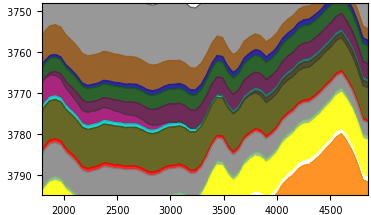COHIBA – Surface Modelling and Depth Conversion
- Department SAND
- Fields involved Structural geology, Geomodelling
COHIBA is a software tool that describes transitions between geological layers. This cutting edge tool is in extensive use in the oil and gas industry.
COHIBA Version 7.1 was released December 23rd 2021. Important improvements are:
- Surfaces can be conditioned on known contacts, for instance contacts extracted from 4D seismic data.
- Significant speedups.
Why use COHIBA?
COHIBA is a fast and accurate tool for making deterministic and stochastic surfaces.
- Conditions to vertical and horizontal wells using various well data: well picks, zone logs, distance data (DDR/RNS), and surface dips
- Handles many surfaces and explicitly takes into account their internal dependencies.
- Handles well path TVD uncertainty in multilateral horizontal wells.
- Analyses input data, filter away erroneous data, and reports problems.
- Thorough analysis of model and data. Extensive reporting.
- Handles large amount of data.
- Stochastic depth-conversion.
- Cross validation of wells.
COHIBA uses the available data in a consistent manner to minimize the uncertainty. The accuracy is further improved by linking together all surfaces in a multi-layered model.
COHIBA provides two ways of evaluating uncertainty:
- A local depth uncertainty at every surface location can be calculated
- Simulated (Monte Carlo) surface realizations can be generated. A set of these spans the uncertainty range
Geosteering
The animation below shows vertical cross sections along a well trajectory, simulating how COHIBA-models can be updated during a drilling process. Notice how the uncertainty band (shaded grey area) of the top surface shrinks as more and more of the well is drilled.

Zone logs give improved surfaces
Below are two cross sections through a real reservoir. In the first figure, well picks have been used for conditioning. In the second figure the whole zone log has been used, and this makes the zonation correct.


Zone logs reduce the uncertainty
The figures below show how the depth uncertainty is reduced when surfaces are conditioned to zone logs.


Method
Layer cake
The subsurface is constructed as a layer cake model where two surface can be connected several ways. For the generated depth surfaces these ways are balanced such that the uncertainty is minimized.
Statistical model
Surfaces are treated as multi-normal distributions that are updated using Bayesian statistics. Both predictions and stochastic realizations can be generated.
Data
Time interpretations, velocity models and isochores are integrated with well data like well picks, zone logs, dips and resistivities to generate optimal depth surfaces. The true-vertical-depth uncertainty in the well path can be integrated.
Bibliography
Almendral Vazquez, A., Dahle, P., Abrahamsen, P., Sektnan, A. “Conditioning geological surfaces to horizontal wells”, Computational Geosciences, 26, pages 1223–1236 (2022), Springer, DOI: doi.org/10.1007/s10596-022-10154-6

